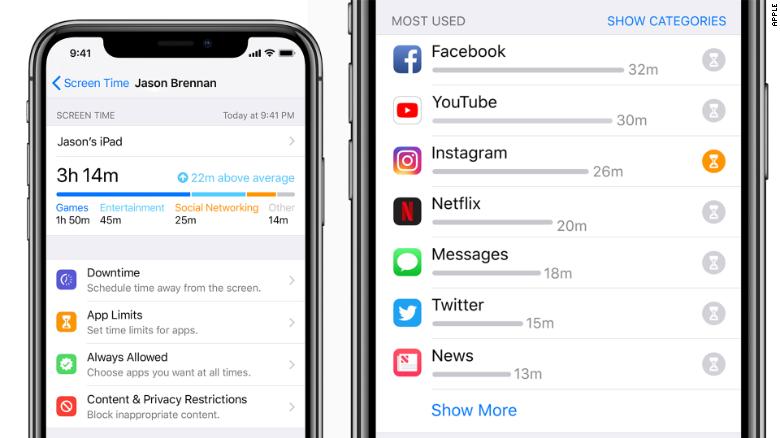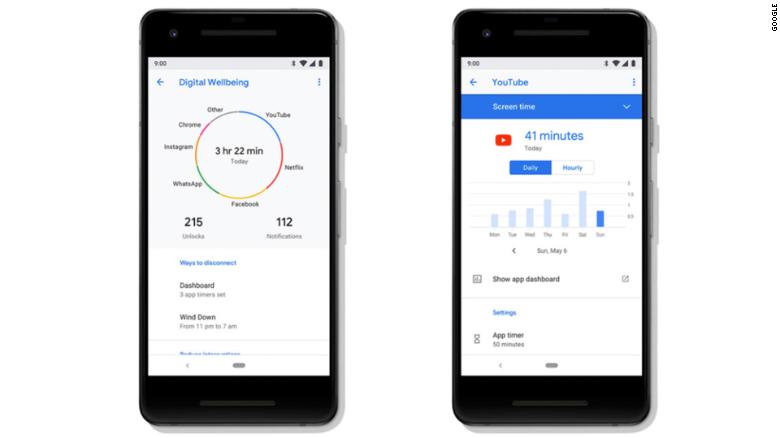How tech companies are addressing screen addiction
By Allen Kim, CNN(CNN)You see your phone light up from the corner of your eye and instinctively reach for it. What started as a simple notification check snowballs into an hour-long session as you swipe through rows of notifications and scroll through endless social media feeds.
This is by design.
From app developers to tech behemoths such as Google and Facebook, companies have spent years working to make consumer technology as addictive as possible. After all, time spent with their products could equal big bucks for the company.
However, that's starting to change, and we could be at the precipice of a shift in how software is designed. Apple and Google are implementing new features aimed at curbing phone usage, and apps like Instagram are rolling out features intended to help you manage your time with the app better.
So, why are they doing this, and is it enough?
Tristan Harris previously worked at Google as a design ethicist, and he saw first-hand how developers worked to capture people's attention and hook them in. He was part of the infamous "Facebook Class" from Stanford. Led by instructor BJ Fogg, who oversaw the Persuasive Technology Lab, they studied how to "persuade users to take certain actions," according to Wired.com. The article stated that the class "developed the techniques to make ... apps and gadgets addictive" and that members of the class went on to create Instagram and design products at companies such as Google, Facebook and Uber.
Fogg told CNN that he disputes the characterization that his class taught people to create addictive technology.
Speaking about his time working at Google, Harris told NPR's TED Radio Hour that "at the end of the day, it was about capturing attention."
"You know, how would we hook people into spending more time on the screen or driving more page views or getting people to click on ads?"
After leaving Google in 2016, Harris went on to found a nonprofit that is now called the Center for Humane Technology, and he started the "Time Well Spent" movement.
"With Time Well Spent, we want technology that cares about helping us spend our time, and our lives, well -- not seducing us into the most screen time, always-on interruptions or distractions," Harris says.
The movement made waves in Silicon Valley and set in motion a sea change in the tech industry.
How are tech companies addressing the issue?
Apple was likely spurred to action after two major investors, Jana Partners and the CalSTRS (California State Teachers' Retirement System), urged the company to help fight phone addiction in children in an open letter to the board of directors at Apple earlier this year.
Apple responded with the introduction of tools in its new iOS 12 operating system aimed at informing and empowering users to better manage their smartphone usage and parental controls that allow parents to better monitor and control their children's phone time.

Apple's Screen Time dashboard in iOS 12
Screen Time is an activity dashboard that gives users a detailed breakdown of how much time they spend with each app, how often they pick up their phone and how many notifications they've received from each app. You're able to set daily limits, which lock the app after you reach your limit. Granted, the lock is easy to bypass; it's more of a reminder that you have reached your limit as opposed to a true barrier to use.
Parents, however, are able to set hard limits on the phones of their children, completely locking them out of apps or categories once they reach their allotted time.
"Consumers -- and parents in particular -- are up against teams of engineers and psychologists designing technology that's meant to keep us constantly engaged," said Christine Elgersma, senior editor of parent education at Common Sense Media. "Even with tools that tell us we're checking Twitter 100 times a day, we may still feel the same compulsion to check because of the way devices and apps are made."
Google has included similar tools in the upcoming version of Android Pie that it's dubbed "Digital Wellbeing," which is currently in beta testing. The tools offered by Apple and Google are almost mirror images of one another, but Google goes a bit deeper than Apple. For instance, the app icon is grayed out once users hit their limit, and to get around the app limit, users have to open the dashboard to manually remove it as opposed to simply clicking the ignore pop-up with iOS 12.
Google also offers a "Wind Down" feature to set at bedtime, which automatically puts the phone into Do Not Disturb mode and puts the entire screen in grayscale mode. No notifications will show up on your phone, and losing all color on-screen is certainly an incentive to put your phone away.

Google's Digital Wellbeing dashboard in Android Pie
"These are band aids," Adam Alter, author of "Irresistible: The Rise of Addictive Technology and the Business of Keeping Us Hooked," tells CNN. "Instead of actually producing tech that's good for us -- that helps us live better lives -- these tools basically suggest that the tech itself can't be improved, so we're stuck with trying to discourage or curb usage."
Alter believes that the way technology is designed needs to be changed so that the addictive features are more consumer friendly and truly good for your well-being. However, he does not believe that change will happen anytime soon, even if these "companies have a moral obligation to minimize the harm they do."
Will new tools impact the bottom line?
Google makes most of its money through ads, and limiting screen time can potentially have an adverse impact on its profits. Still, the company is investing in Digital Wellbeing. Even if Google's products never get to the point of being friendlier to consumers, as Alter has suggested, Google has made a conscious decision to put profits at risk.
"We take our responsibility to our users and society very seriously and strive to build products that make people's lives easier, not detract from them," a spokesperson for Google tells CNN. "We have been working hard to add key capabilities right into our products, and our goal is to help users achieve the balance with technology they're looking for, with a focus around awareness of their current behavior, and controls to help them interact with their devices."
"At this point we know devices are here to stay, and we see that there are effects around how we use it," Elgersma says. "Instead of psychologists working to keep us hooked, what if we had child development experts involved in the development of tech kids are using, especially since those creating tech often aren't yet parents?
"What if we funded research and education around these issues so that the generations who are growing up online with devices were better equipped to use them responsibly and knew the proven, long-term effects of overuse? So, we all have an obligation for kids, but the responsibility should be shared more equally, starting with those who create the tech in the first place."
When is screen time a problem?
There are still no clear guidelines on what constitutes tech addiction, but it's a growing concern likely on the minds of parents everywhere as they see their kids' faces constantly glued inches away from a screen. And everywhere you go, you're all but guaranteed to see people buried in their phones.
"The term 'tech addiction' is itself empty," Alter says. "Tech itself is only the vehicle for hundreds of different experiences, some of which undoubtedly become addictive for some people. They vary considerably, so I prefer not to use a single label to describe them, though most are delivered on screens."
Apple and Google may be the two biggest culprits, as their products are the vehicles to deliver these experiences. However, Facebook deserves a fair amount of blame, as CEO Mark Zuckerberg acknowledged in a blog post earlier this year, directly referencing the Time Well Spent movement. The social network announced plans to roll out changes aimed at making interactions more meaningful.

Facebook CEO Mark Zuckerberg
"By making these changes, I expect the time people spend on Facebook and some measures of engagement will go down," Zuckerberg said. "But I also expect the time you do spend on Facebook will be more valuable. And if we do the right thing, I believe that will be good for our community and our business over the long term too."
Facebook and Instagram have begun to roll out features to better engage with their platforms, and users will soon have access to an activity dashboard, a daily reminder limit and more controls over notifications.
"What matters most in the long run is that people connect and share in meaningful ways on our platforms," Ameet Ranadive, Product Management Director at Instagram, tells CNN. "It's very important that people feel like the time they spend with Facebook and Instagram is time well spent."
No comments:
Post a Comment